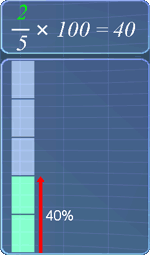Convert Fraction to Percent
Lesson Objective
In this lesson, we will learn how to convert fraction to percent.
About This Lesson
In this lesson, we will:
- Learn the basics behind converting fraction to percent
- Learn the steps to quickly perform the conversion.
- See some examples on using these steps.
The study tips and math video below will explain more.

Study Tips
Tip #1
A fraction can be converted to percent. The example below shows how you can quickly convert 3/5 to percent:
-
First, we multiply the fraction with 100 as shown below.

-
Next, we multiply 100 with the fraction's numerator, 3. This gives 300.

-
Now, we divide 300 with the fraction's denominator, 5. This gives 60. Don't forget to include the % sign to show that the calculated number is 'per' 100 (i.e. percent). After conversion, we have 60%.

The math video below will give more explanations on this. Also, we will see some examples on it.
Math Video
Lesson Video
Sponsored Links

Please support us by downloading our Fraction Basics app and subscribe to get all 12 video lessons and All Access pass to 8 Zapzapmath Home apps with 180 math games from as low as US$1.67/month:
Apple App Store (iOS) |
Google Play (Android)
Math Video Transcript
00:00:03.210
In this lesson, we will learn how to convert fraction to percent.
00:00:08.190
Consider this fraction, 2/5. Now, this fraction can be visualized by this bar.
00:00:17.080
The denominator 5, means that this bar is divided into 5 equal parts.
00:00:23.000
The numerator 2 means that 2 out of 5 parts are selected, as shown by these green parts.
00:00:29.170
Now, let's see some explanation on converting this fraction, 2/5, to percent.
00:00:36.240
Note that, we will learn a quicker way to do the conversion later.
00:00:41.200
Let's start. First, we multiply 2/5, with 100.
00:00:48.020
Now, we know that 100 is the same as, 100/1. With this, we are now multiplying these 2 fractions.
00:00:58.060
Multiplying these fractions gives, (2x100)/(5x1).
00:01:05.080
Simplifying this term gives, 200/5.
00:01:09.200
Next, 200 divided by 5 gives, 40. Since we are finding the percentage, it is important to include the percent sign.
00:01:20.220
So we have, 40%.
00:01:24.170
Visually, we can see that when the fraction is 2/5, the green parts take up 40% of the entire bar. When the numerator is 3, the green parts now take up 60% of the entire bar.
00:01:39.190
Next, when the numerator is 4, the green parts takes up 80% of the entire bar.
00:01:46.230
Similarly, when the numerator is 5, which the same as the denominator, the green parts take up 100% of the entire bar.
00:01:57.100
Alright, let's change this fraction back to 2/5.
00:02:03.070
Now, let's learn the quicker way to convert fraction to percent, using the following steps.
00:02:09.200
We can start by multiplying this fraction with 100.
00:02:14.160
Next, we multiply 100 with the numerator, 2. This gives 200.
00:02:22.090
Then, we divide 200 with the denominator, 5. By doing so, we get 40.
00:02:32.010
Since we are calculating the percentage, it is important to include the percent sign.
00:02:38.210
Finally, we have 40%. This is the same value that was calculated earlier.
00:02:46.120
Let's see another example. Convert 3/4 to percent.
00:02:53.020
Again, we start by multiplying the fraction 3/4, with 100.
00:02:59.020
Next, we take 100 and multiply it with 3. This gives, 300.
00:03:07.210
Now, we take 300 and divide it with the denominator, 4. By doing so, we get 75.
00:03:17.200
Remember, it is important to include the percent sign.
00:03:22.240
Finally, we have 75%. Visually, we can see the 75% here.
00:03:33.050
This is all for this lesson. Try out the practice questions to further your understanding.
Practice Questions & More
Multiple Choice Questions (MCQ)
Now, let's try some MCQ questions to understand this lesson better.
You can start by going through the series of questions on converting fraction to percent or pick your choice of question below.
- Question 1 on converting fraction to percent
Site-Search and Q&A Library
Please feel free to visit the Q&A Library. You can read the Q&As listed in any of the available categories such as Algebra, Graphs, Exponents and more. Also, you can submit math question, share or give comments there.


